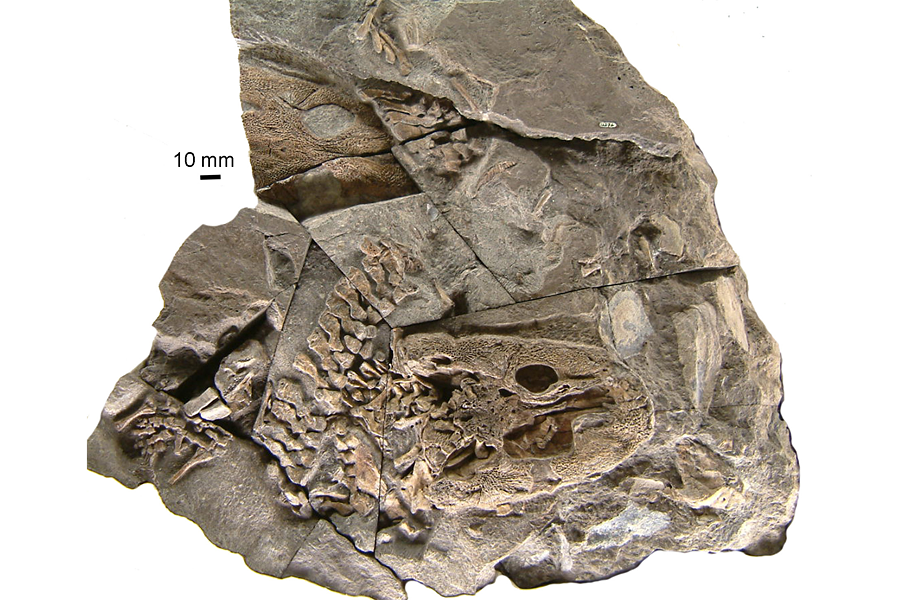Will teenage tetrapods change the story of leap from sea to land?
Sometimes age does matter.
When a group of early limbed animals, of the genus Acanthostega, died about 360 million years ago in what is now Greenland, they were just juveniles, according to a study published Wednesday in the journal Nature.
These leggy vertebrates have been hailed as key fossils helping scientists stitch together the picture of the evolutionary leap from sea to land. But because they weren't fully grown as previously thought, the iconic fossils could revise that story.
"Everybody assumed that they were adult individuals," study lead author Sophie Sanchez, a paleontologist at Uppsala University in Sweden and the European Synchrotron Radiation Facility, tells The Christian Science Monitor.
"If you assume that all the fossils that we have found are adults," she says, "then you can make a lot of theories about the transition from the water environment to the land environment."
These individuals were aquatic, Dr. Sanchez says. Because their bones develop later in life and they had well-developed gill skeletons, these Acanthostega specimens certainly weren't running around on land, she asserts.
But they also weren't fully developed, and if animals living today are any indication, it's possible for juveniles to be obligate swimmers while adults can go on land. Sanchez points to some salamanders as an example of that maturation in living animals.
Researchers have yet to find any adult specimens of the genus, says Sanchez, "So for now, we don't know if the adults were terrestrial or aquatic."
Most of the evidence in the fossil record points to early tetrapods (limbed vertebrates) being largely aquatic, Ted Daeschler, associate curator and chair of vertebrate zoology at the Academy of Natural Sciences in Philadelphia, who was not part of the study, tells the Monitor. But "There's no reason that early tetrapods didn't fill a variety of niches," he says.
So even if researchers can pin down whether or not an adult Acanthostega was terrestrial, it still might not explain exactly how vertebrates went from being swimmers to walkers.
"But at least we're putting together a good knowledge of the life history of Acanthostega," Dr. Daeschler says. "And of course we would like to extend the knowledge that we have about Acanthostega now to other taxa."
How do you figure out how old the animal was when it died?
A quick way to estimate an individual animal's age is by its size, but that method is imprecise – particularly when dealing with fossils that scientists know little about, says Daeschler.
Figuring out fossils takes finesse. Sanchez knows that.
Bones, like trees, lay down rings as they grow that then correspond to their age. So Sanchez needed to peek inside the bones of the Acanthostega individuals to study their life histories.
But there was a problem. At the time, the only way to do that was to slice into the fossils, and Sanchez knew nobody would let her section such precious, rare specimens. So she had to innovate.
Sanchez and her paleontologist colleagues teamed up with researchers at the European Synchrotron Radiation Facility and developed a new, non-invasive technique to map the microstructures within fossilized bone. They took high-resolution synchrotron X-ray scans of the forelimbs of the tetrapods.
So now nearly three decades after University of Cambridge paleontologist Jennifer Clack discovered the assemblage of Acanthostega fossils in 1987 in Greenland, scientists are able to answer simple questions about the individual animals themselves. Dr. Clack is a co-author on the new paper.
"New technologies are certainly opening up some new opportunities to look at things that we never really had great options to in the past," Daeschler says. "This is a good example of that, of the way that new technology can be applied to answer vexing problems."
Daeschler, who describes himself as "old school," says this study is a good example of how the field of paleontology is changing and is able to address more detailed questions using new techniques.
"Thirty years ago, it was very rudimentary. It was just a few datapoints" behind the ideas being bandied about regarding tetrapods' transition from aquatic to terrestrial environments, he says. "Well those datapoints are coming fast and furious now. They're both field discoveries and new techniques, and just new minds looking at it."
"We're really in a golden age of understanding this transition," Daeschler says.






